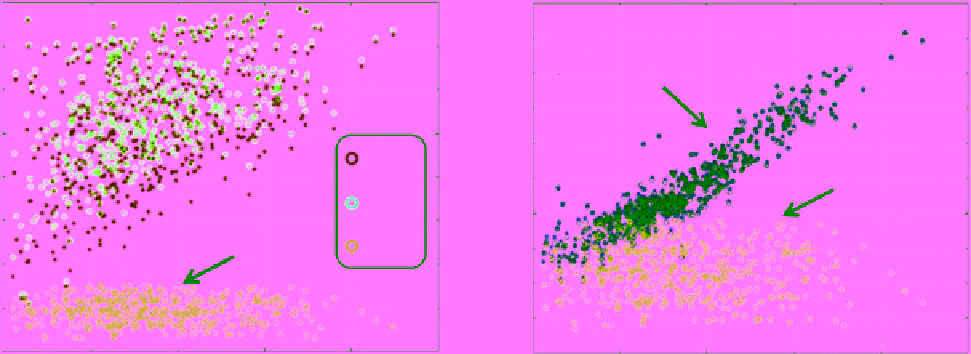Geology Reference
In-Depth Information
incidence angle range (40°-50°), but the wind speed over
area 4 is significantly higher than area 3 (19 and 4 m/s,
respectively). This is reflected in their average backscatter
(−13.08 and -24.03 dB, respectively).
Vachon and Wolfe
[2011] compiled a data set of ocean
backscatter from Radarsat‐2 fine beam mode and com-
pared it to the wind speed at 10 m above the surface to
develop empirical relationships valid for co‐ and cross‐
polarization backscatter. The wind speed data were
obtained from operational weather buoys maintained by
Environment Canada and Fisheries and Oceans Canada
off the east and west coasts of Canada. The data were cor-
rected to the equivalent neutral stability wind speed at a 10
m height
U
10
using the difference between the air and sea
surface temperature and the known anemometer height.
Plots of co‐ and cross‐polarization backscatter versus
U
10
are shown in Figure 8.9. The backscatter equivalent of the
instrument noise floor
The authors recommend that this relationship can be
applied to other modes of Radarsat‐2 or other C‐band
SAR systems provided that the noise floor is not higher
than that of Radarsat‐2. The noise floor imposes a limit
on the minimum speed that can be calculated.
Zhang and
Perrie
[2012] have confirmed the applicability of equation
(8.9) also using Radarsat‐2 data. It is recommended to use
the equation for the co‐polarization data as well. The root‐
mean-square (rms) error for wind speed retrieval using
cross‐polarization data is better than 2 m/s while it is
around 2.5 m/s when using either
HH
or
VV
polarization.
The relationship between cross‐polarized radar backscat-
tering and surface wind speed over the ocean was examined
also in
Voronovich and Zavorotny
[2011]. The study modeled
the cross‐polarized backscatter from wind‐driven ocean sur-
face roughness using the small‐slope approximation of the
second‐order (SSA2) model. The model accounts for Bragg
scattering of the second order, which involves intermediate
waves propagating at zero grazing angles. Comparison of
results from this model against a modified version where the
contributions from resonances with grazing waves are
removed (known as the SSA2‐0 model) was also performed.
Results show higher sensitivity of
0
is plotted in each figure. The
backscatter coefficient data from any co‐polarization
measurements (
NE
0
) reveal more scattering than the
cross‐polarization data. It should be noted that the effect
of incidence angle is not taken into consideration in this
data set. The cross‐polarization backscatter is not sensi-
tive to the incidence angle. Other plots in
Vachon and
Wolfe
[2011] show an obvious trend of co‐polarization
backscatter decrease with increasing incidence angle and
independence of cross‐polarization backscatter of the
incidence angle. This led the authors to develop the follow-
ing relationship between the C‐band cross‐polarization
backscatter and wind speed:
0
or
vv
hh
0
to the wind speed
compared to its sensitivity to the incidence angle. The
SSA2‐0 model produces less cross‐polarization backscatter
than the SSA2 model by 2-4 dB, which agrees more with the
Radarsat measurements in the range 8-18 m/s of wind
speed. Admittedly, measurements of the low values of
hv
0
hv
at wind speed <10 m/s may not be accurate because of the
cross‐talk between orthogonal components of the received
signal. The conclusion from these discussions is that
although the cross-polarized return from OW at C‐band
increases with the surface wind speed, the backscatter range
0
10
0 592
.
U
35 6
.
(8.9)
vh
N
0
-20
-22
-5
σ
hv
&
σ
vh
-24
-10
-26
-15
-28
σ
hh
-20
-30
σ
NE
σ
vv
-32
-25
σ
NE
σ
NE
-34
-30
-36
-35
-38
-40
-40
0
5
10
15
20
25
0
5
10
15
20
25
U
10
U
10
m/s
m/s
N
N
Figure 8.9
Radarsat‐2 backscatter from ocean surface plotted against measurements of wind speed at 10 m level
from weather buoys. Co‐polarization and cross‐polarization backscatter measurements are shown in the left and
right panels, respectively.
NE
0
is the instrument's noise floor [adapted from
Vachon and Wolfe
, 2011]. (For color
detail, please see color plate section).








